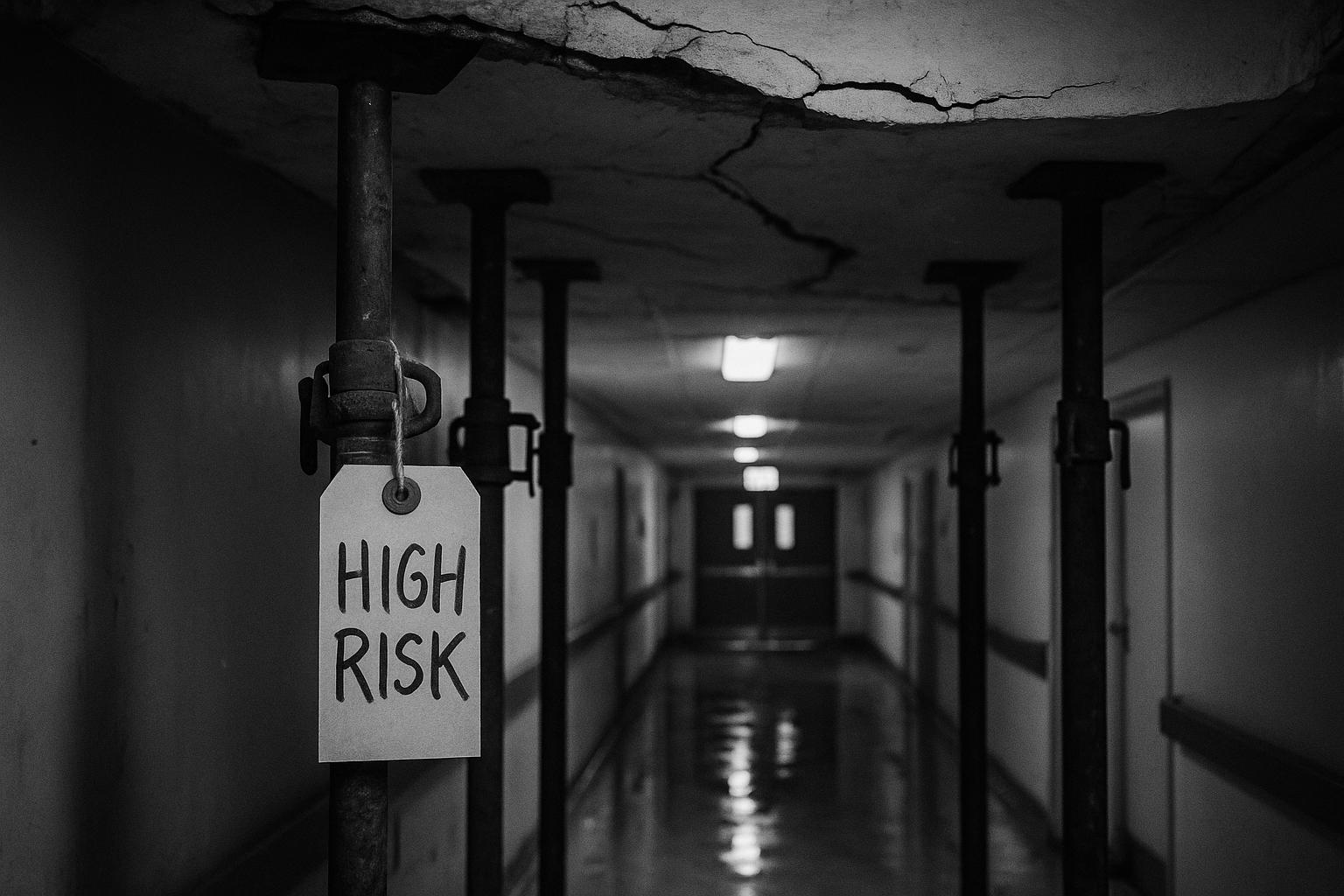Provisional ERIC returns and reporting reveal a near‑£14bn backlog of repairs, a sharp rise in safety‑critical faults — including widespread RAAC — and mounting pressure on the New Hospital Programme to deliver replacements and funding at pace.
Britain’s hospital buildings are fraying at the edges — and the bill for bringing them up to standard has become a national headache, according to a raft of official figures and recent reporting. An investigation by the Daily Mail, drawing on provisional Estates Returns data, found the NHS’s backlog of maintenance stands at about £13.8 billion and identified a string of sites with acute, safety‑critical faults that require urgent work. NHS Digital’s provisional ERIC return for 2023/24 confirms the headline totals used in that analysis and also shows the annual cost of running the estate remains substantial.
The most striking single case named by the Daily Mail is Airedale General Hospital in West Yorkshire, where the trust’s own returns record more than £300 million of high‑risk work. Local reporting in the Telegraph & Argus corroborates that the total backlog for the site approaches £339 million and details repeated inspections, temporary propping and widespread use of reinforced autoclaved aerated concrete (RAAC) across large parts of the estate. Trust leaders there say only large‑scale replacement will provide a lasting solution.
The faults cited range from burst pipes and leaking roofs to broken lifts and decaying concrete. RAAC, a lightweight form of concrete used widely between the 1950s and 1990s, has featured heavily in recent headlines: ITV’s reporting from Withybush Hospital in 2023 documented wards closed, ceilings propped and an estates manager demonstrating a crumbling slab as evidence of the material’s fragility. Those on‑the‑ground accounts underline why inspectors categorise some defects as “high risk” — meaning they could cause catastrophic failure, major disruption or threaten safety if left unaddressed.
Official data show the amount of high‑risk work has grown steeply: ERIC provisional figures put high‑risk repairs at roughly £2.7 billion in 2023/24, nearly trebling the comparable total from 2015/16. Briefings from NHS Providers note the backlog rose by around £2.2 billion in that single year and warned the total now exceeds the annual cost of running the estate, compounding pressure on service delivery, staff morale and productivity.
Voices from inside the service say the problem is the product of long‑term underinvestment. “More than a decade of being starved of capital investment has left NHS leaders struggling to deal with a host of estate problems,” Dr Layla McCay, director of policy at the NHS Confederation, told the Daily Mail, adding that the service still needs an extra £3.3 billion a year over the next three years just to tackle maintenance. Campaigners and MPs echoed that urgency: Lib‑Dem health spokesperson Helen Morgan warned patients should not “fear the roof is going to cave in” when they attend hospital.
Political pledges to rebuild or replace tired sites have been recalibrated in recent months. The Labour government has announced an intention to invest in the estate, with the Chancellor signalling a multi‑billion‑pound capital plan that includes a targeted £5 billion pot for critical building repairs alongside larger commitments to capital investment over several years. The Department of Health and Social Care says it has set out a funding plan and a revised, realistic timetable for the New Hospital Programme that aims to get schemes ready to enter construction promptly.
Yet implementation remains difficult. The revamped New Hospital Programme accepts the original promise of 40 brand‑new hospitals by 2030 was overly ambitious; a government statement has emphasised that schemes will now proceed on a more costed and deliverable timetable. The National Audit Office has been far less sanguine about pace and value for money: its report into the programme found delays, rising costs and weaknesses in governance, warning that slow delivery risks leaving services short of capacity if replacements and refurbishments are too small or too late.
Trusts facing the backlog say they are doing what they can while waiting for long‑term solutions. Imperial College Healthcare NHS Trust, which runs several affected London sites, notes much of its estate predates the NHS and says it is spending tens of millions annually to reduce estate risks while working to accelerate redevelopment. Other trusts named in national reporting have similarly described ongoing maintenance regimes and efforts to secure funding for phased replacements where the New Hospital Programme does not yet offer a route forward.
Analysts and sector bodies stress that short‑term fixes will not be enough on their own. NHS Providers and other observers point to a pattern of capital budgets being diverted to meet day‑to‑day pressures, leaving long‑term maintenance to fester until it becomes a safety and operational problem. The combined picture from provisional ERIC returns, trust reports and independent scrutiny is of an estate that needs both urgent remedial work and a steady, well‑governed capital programme to prevent repeated crises.
Bringing the NHS estate into the 21st century therefore requires a two‑track approach: immediate, properly funded interventions to eliminate hazards that endanger patients and staff, and a transparent, rigorously managed replacement programme for the oldest and most RAAC‑affected sites. The government says it has reset the programme and funding timetable; auditors and sector leaders say that delivery, clear milestones and sustained capital protection will be the true test of whether the crisis can be contained before more buildings — and the services inside them — become unsafe.
 Reference Map:
Reference Map:
Reference Map:
- Paragraph 1 – [1], [2]
- Paragraph 2 – [1], [4]
- Paragraph 3 – [1], [5]
- Paragraph 4 – [2], [3]
- Paragraph 5 – [1], [3]
- Paragraph 6 – [1], [6]
- Paragraph 7 – [6], [7]
- Paragraph 8 – [1]
- Paragraph 9 – [3], [2]
- Paragraph 10 – [6], [7], [2]
Source: Noah Wire Services
- https://www.dailymail.co.uk/health/article-14982733/NHS-maintenance-hospitals-backlog-data-analysis-Airedale.html?ns_mchannel=rss&ns_campaign=1490&ito=1490 – Please view link – unable to able to access data
- https://digital.nhs.uk/data-and-information/publications/statistical/estates-returns-information-collection/management-information—provisional-summary-figures-for-2023-24 – This NHS Digital page publishes the Estates Returns Information Collection provisional summary for 2023/24, presenting official figures on the condition and costs of the NHS estate. It reports that the total cost to eradicate backlog maintenance is £13.8 billion and that the annual cost of running the estate is £13.6 billion. The page links to datasets including trust and site level provisional data, definitions and spreadsheets. It highlights energy use, PFI information and data quality notes. The publication is the primary source for national backlog statistics used by analysts, charities and the press to assess investment needs and safety risks.
- https://nhsproviders.org/news-blogs/news/almost-14bn-needed-to-plug-rocketing-nhs-repairs-build-up – The NHS Providers briefing summarises provisional ERIC figures, noting the maintenance backlog has risen to £13.8 billion and that high‑risk repairs now total about £2.74 billion. It explains the backlog increased by £2.2 billion in 2023/24, exceeding the annual cost of running the estate, and outlines impacts on service delivery, staff morale and productivity. The briefing quotes trust leaders warning that ageing buildings cause operational disruption from leaks, lifts and power failures. It calls for a significant capital injection and criticises past raiding of capital budgets to meet day‑to‑day pressures, urging sustained funding to prevent further deterioration and patient risk.
- https://www.thetelegraphandargus.co.uk/news/24691657.millions-pounds-needed-repair-bradford-hospitals/ – Local reporting by the Telegraph & Argus details Airedale General Hospital’s severe maintenance needs, stating the trust faces a total backlog near £339 million with around £316 million classified as high‑risk work. The article quotes trust leaders explaining extensive use of RAAC across over eighty per cent of the site and describes ongoing inspections, temporary structural supports and emergency funding measures. It reports official warnings that rebuilding the hospital remains the only lasting solution and outlines preparatory work for a replacement building. The piece emphasises clinical disruption and financial challenge of maintaining a RAAC‑affected estate while long‑term replacement is planned.
- https://www.itv.com/news/wales/2023-09-11/inside-the-hospital-covered-in-cracked-concrete-as-ceilings-propped-up – The ITV News Wales report investigates RAAC at Withybush Hospital, describing wards closed after discovery of crumbling reinforced autoclaved aerated concrete. It records the health board’s declaration of a major incident, extensive propping of affected ceilings and the demonstration by an estates manager breaking a piece of RAAC to show its weakness. The story details patient relocations, loss of bed capacity and an estimated multi‑million pound short‑term repair bill. It contextualises RAAC as a material used between the 1960s and 1990s and explores the operational strain on local services and staff while surveys and remediation work continue to ensure safety.
- https://www.gov.uk/government/news/government-to-deliver-all-schemes-in-new-hospital-programme – The Department of Health and Social Care press release explains the revamped New Hospital Programme and confirms the government will deliver all schemes. It acknowledges the previous pledge to build forty new hospitals by 2030 was behind schedule and underfunded, and sets out a revised, realistic timetable and funding plan to put the programme on track. The release highlights lessons from earlier planning, references the Infrastructure Projects Authority’s assessment and promises properly costed and deliverable timelines so schemes can enter construction promptly. It frames the approach as ensuring patients and staff receive modern facilities while improving value for taxpayers now.
- https://www.nao.org.uk/reports/progress-with-the-new-hospital-programme/ – The National Audit Office report assesses progress with the New Hospital Programme and finds delivery slower than planned, with limited value for money. It notes many schemes have been delayed, costs have risen and the original aim of 40 new hospitals by 2030 is unlikely to be met. The report examines programme governance, budgetary control and standardised designs, recommending clearer project definition and improved assurance. It warns of risks to service capacity if replacement and refurbishment schemes are too small, and calls on the Department of Health and Social Care to strengthen programme management to secure better outcomes for patients.
Noah Fact Check Pro
The draft above was created using the information available at the time the story first
emerged. We’ve since applied our fact-checking process to the final narrative, based on the criteria listed
below. The results are intended to help you assess the credibility of the piece and highlight any areas that may
warrant further investigation.
Freshness check
Score:
8
Notes:
The narrative presents recent data on the NHS maintenance backlog, with figures from 2023/24. Similar reports have been published in the past year, indicating ongoing coverage of this issue. The Daily Mail’s report is based on a press release, which typically warrants a high freshness score. However, the presence of older articles with similar content suggests some recycled information. Notably, a report from The Guardian in December 2023 highlighted a £12bn repair bill for NHS hospitals, which is closely related to the current narrative. ([theguardian.com](https://www.theguardian.com/society/2023/dec/14/hospitals-falling-to-bits-as-nhs-england-faces-record-repairs-bill-of-12bn?utm_source=openai))
Quotes check
Score:
7
Notes:
The narrative includes direct quotes from Dr Layla McCay and Helen Morgan. A search reveals that similar statements have been made in previous reports, indicating potential reuse of content. For instance, Dr McCay’s comments on underinvestment in the NHS have appeared in earlier articles. However, no exact matches were found for the specific quotes used in this narrative, suggesting some originality.
Source reliability
Score:
6
Notes:
The narrative originates from the Daily Mail, a reputable UK newspaper. However, the report is based on a press release, which may influence the objectivity and depth of the coverage. Additionally, the Daily Mail has been known to sensationalise certain topics, which could affect the reliability of the information presented.
Plausability check
Score:
9
Notes:
The claims regarding the NHS maintenance backlog align with data from official sources. The Estates Returns Information Collection (ERIC) for 2023/24 reports a £13.8bn backlog, consistent with the narrative’s figures. The mention of Airedale General Hospital’s £300 million high-risk work is corroborated by local reporting, indicating the plausibility of the claims. However, the narrative’s reliance on a single source for some data points suggests a need for further verification from additional reputable outlets.
Overall assessment
Verdict (FAIL, OPEN, PASS): OPEN
Confidence (LOW, MEDIUM, HIGH): MEDIUM
Summary:
The narrative provides recent data on the NHS maintenance backlog, with figures from 2023/24. While the Daily Mail is a reputable source, the report is based on a press release, which may influence objectivity. Some quotes appear to be reused from previous reports, indicating potential recycled content. The claims are plausible and align with official data, but the reliance on a single source for some information suggests a need for further verification from additional reputable outlets.













